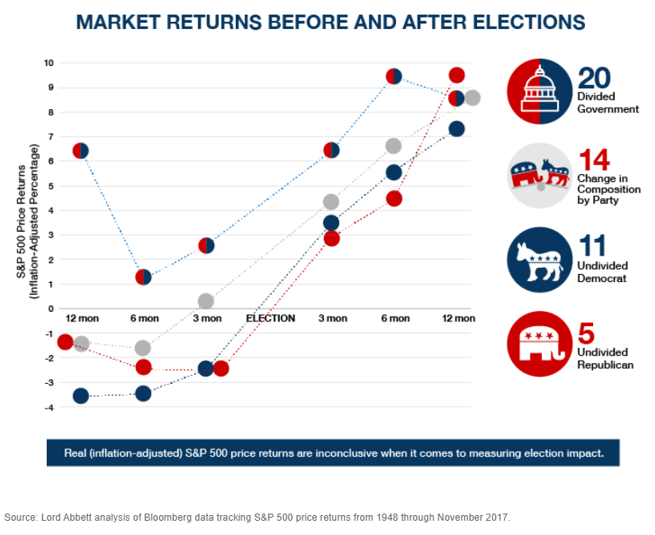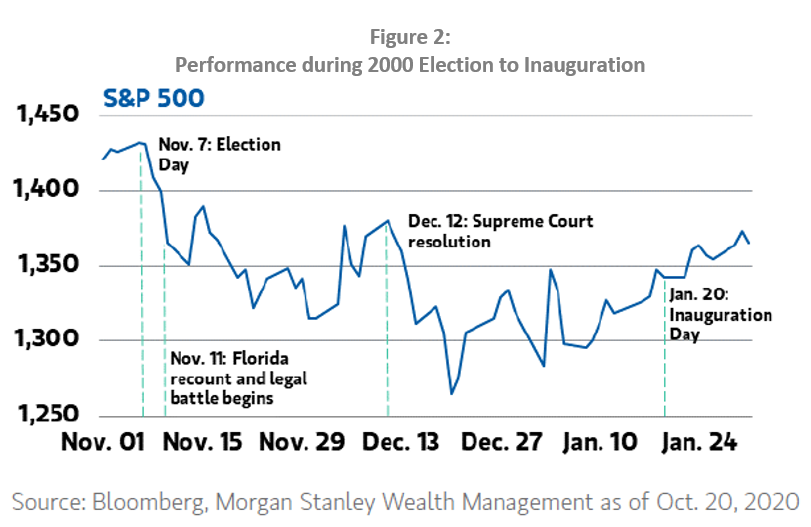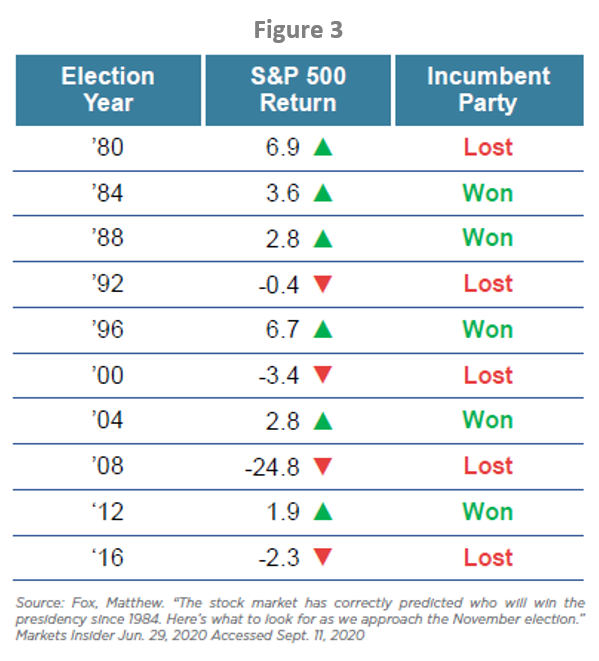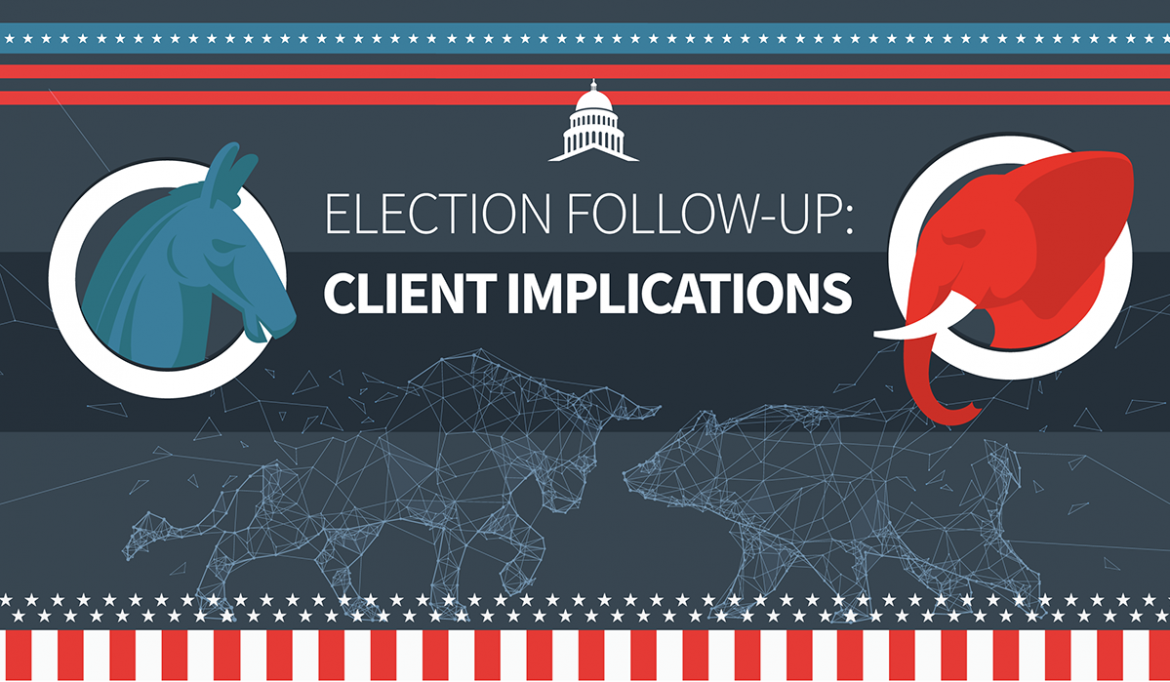Updated September 6, 2023, at 9:51 PM
With the long-awaited election results in hand, many investors are asking themselves what to expect from the markets with a Biden-Harris administration in the White House.
After a decade-long bull run was interrupted by a global pandemic, investors are understandably seeking a return to baseline, turning to pundits to predict the best chances to do so. Unfortunately, an election taking place at the height of an unprecedented year doesn’t exactly lend itself to historical comparisons.
Still, there are some patterns we can look toward to understand where we are and where we might be going.
Rally Red or Booming Blue?
If you’ve read The 2020 Election and the Star-Spangled Stock Market, you already know that political parties don’t historically have a huge impact on market performance. Even when party lines shift across history, the truth is, presidents don’t operate in a vacuum. And a few major corporations most heavily influence the markets.
So, if your clients are considering pulling their funds based on party affiliation, evidence suggests they best stay put and stick to the long-term plan you’ve created.
A Divided Government
Another piece of good news for investor clients is that we’re headed for a divided government. There will be a Republican-controlled Senate and a Democratic-controlled House of Representatives.
As you can see in Figure 1, a divided government has historically produced the best returns overall. While past performance can’t guarantee future results, investors can take some comfort in the fact that this balance of power will oblige more middle-of-the-road solutions to some of the more progressive proposals from the incoming administration.

Related: Horizon Investments and Goals-based Investing
Biden Tax Plans
Many investors are concerned about the impact that Democratic leadership will have on their tax bill more so than their portfolio performance. It’s a valid concern, but a divided government will likely result in more moderate tax law changes as well, compared to the initial proposals from the Biden ticket. Many of those proposals depended on a Democratic sweep of Congress and the presidency, which didn’t happen.
Some of the proposed changes include:
- Raising the top individual tax rate from 37% to 39.6%
- Extending the Social Security tax from earnings up to $137,700 to earnings over $400,000
- Raising the capital gains rate to 39.6% for taxpayers with income over $1 million
If you have clients concerned about how these shifts may affect them, now’s a great time to sit down with them to discuss how they can face these changes by utilizing tax-advantaged vehicles designed to restructure investments while continuing to work toward their long-term objectives.
Impacts of a Contested Election
A piece of bad news: the contested election will likely result in a period of volatility. The most recent experience we have before this year was the 2000 election between George W. Bush and Al Gore. After Florida was called in favor of Republican candidate Bush, the results were called into question when voters in one Florida county claimed that the “butterfly ballot” was confusing and many voters feared they didn’t vote for their intended candidate. The recount process marked a period of volatility for investors, as demonstrated in Figure 2.
Of course, that was a very different election—particularly since only one state—won by a very narrow margin—was contested.

We’re still waiting to learn a lot more about the ensuing legal process itself. With lawsuits and threats of lawsuits abound, The Supreme Court may be inching closer to taking up an election fraud case. How far it’ll move forward, and how many states get involved, is still unclear at the time of this writing.
Although the markets are likely to react to such a period of uncertainty, it behooves clients to remember that a resolution will ultimately be made, and the markets will stabilize once again. While it may be tempting to opt-out during this period or even attempt to “time the markets,” periods of volatility don’t only move in one direction, and the high points tend to follow the low points very closely.
Related: Betashield™: Managing Investment Risk
Coronavirus
We can’t talk about market performance in 2020 without mention of the Coronavirus.
In terms of the pandemic, we aren’t out of the woods yet. The full economic impact remains to be seen, as does the new administration’s approach to solving it. As with much of the pre-election volatility, it won’t be easy to pinpoint which moving parts of the economic landscape are influencing the markets at any given time. One important factor to keep in mind is that the stock market and the economy aren’t synonymous.
While they often follow the same patterns, the stock market is comprised of corporations—predominantly five key tech giants: Amazon, Alphabet, Apple, Microsoft, and Facebook. Their industries have been relatively safe from the economic shutdown while unemployment, GDP, retail spaces, and small businesses have been impacted significantly.
Luckily, in terms of market performance, it appears the initial Coronavirus panic has mostly subsided. However, the path forward from an economic standpoint is still unclear.
Betting on the Horses
We didn’t forget about those of you taking bets.
In The 2020 Election and the Star-Spangled Stock Market, we debunked some myths between politics and the stock market. However, one relationship has held statistical significance: when the markets are up the months preceding the election, the incumbent party is likely to be re-elected. When the markets are down, the opposition is more likely to win.
The historical manifestation of this relationship is shown in Figure 3. During the 2020 election, the S&P 500 was down .04% for the third quarter of the year. The opposition party was elected over the incumbent, making it 21 out of 24 elections to be correctly predicted by this method.

Words to Remember
The sage wisdom “only time will tell” can often feel anti-climactic and even frustrating when clients face uncertainty about the future. It is, however, one of the great lessons from a year that has been a whirlwind of historic hurdles and uncharted territory for individuals and the community at large.
Only time will tell if this new administration will positively or negatively impact the markets; only time will tell if we’re at the end or at the height of the pandemic.
But if time has told us one thing: your clients’ best bet is to stay true to the long-term strategy you’ve helped them build. Work with them to listen and understand their unique circumstances and objectives and stay the course with a plan that doesn’t break at the first sign of disruption.
It’s a great time to evaluate their portfolio and ensure that the long-term objectives are front-and-center in their financial plan.
Keep Reading: Portfolio vs. Planning: How to Win & Retain High Net Worth Clients
Disclosure: The content of this article is for informational purposes only and does not represent legal, tax or investment advice. This article is not an offer to buy, sell, replace or exchange any financial product. Past performance is not indicative of future earnings or results. Actual results will vary and may be based on many factors not discussed within this article. The opinions expressed herein may not be representative of the firm providing this article.

